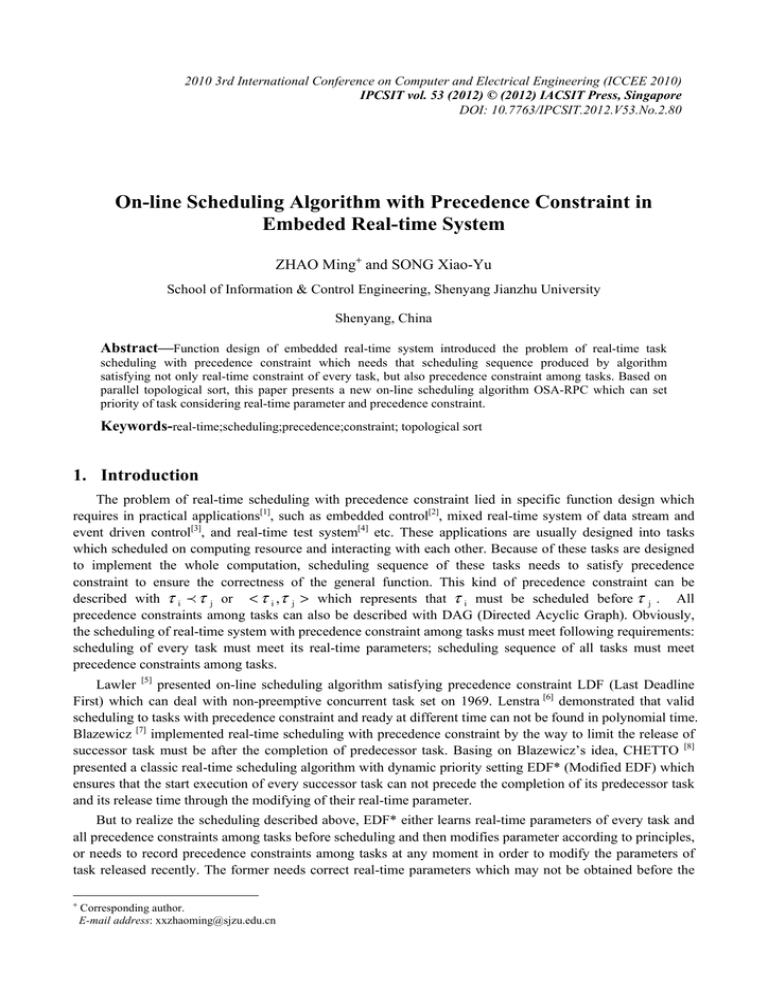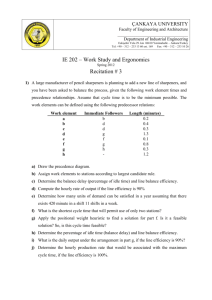On-line Scheduling Algorithm with Precedence Constraint in Embeded Real-time System ZHAO Ming
advertisement

2010 3rd International Conference on Computer and Electrical Engineering (ICCEE 2010)
IPCSIT vol. 53 (2012) © (2012) IACSIT Press, Singapore
DOI: 10.7763/IPCSIT.2012.V53.No.2.80
On-line Scheduling Algorithm with Precedence Constraint in
Embeded Real-time System
ZHAO Ming+ and SONG Xiao-Yu
School of Information & Control Engineering, Shenyang Jianzhu University
Shenyang, China
Abstract—Function design of embedded real-time system introduced the problem of real-time task
scheduling with precedence constraint which needs that scheduling sequence produced by algorithm
satisfying not only real-time constraint of every task, but also precedence constraint among tasks. Based on
parallel topological sort, this paper presents a new on-line scheduling algorithm OSA-RPC which can set
priority of task considering real-time parameter and precedence constraint.
Keywords-real-time;scheduling;precedence;constraint; topological sort
1. Introduction
The problem of real-time scheduling with precedence constraint lied in specific function design which
requires in practical applications[1], such as embedded control[2], mixed real-time system of data stream and
event driven control[3], and real-time test system[4] etc. These applications are usually designed into tasks
which scheduled on computing resource and interacting with each other. Because of these tasks are designed
to implement the whole computation, scheduling sequence of these tasks needs to satisfy precedence
constraint to ensure the correctness of the general function. This kind of precedence constraint can be
described with τ i ≺ τ j or < τ i ,τ j > which represents that τ i must be scheduled before τ j . All
precedence constraints among tasks can also be described with DAG (Directed Acyclic Graph). Obviously,
the scheduling of real-time system with precedence constraint among tasks must meet following requirements:
scheduling of every task must meet its real-time parameters; scheduling sequence of all tasks must meet
precedence constraints among tasks.
Lawler [5] presented on-line scheduling algorithm satisfying precedence constraint LDF (Last Deadline
First) which can deal with non-preemptive concurrent task set on 1969. Lenstra [6] demonstrated that valid
scheduling to tasks with precedence constraint and ready at different time can not be found in polynomial time.
Blazewicz [7] implemented real-time scheduling with precedence constraint by the way to limit the release of
successor task must be after the completion of predecessor task. Basing on Blazewicz’s idea, CHETTO [8]
presented a classic real-time scheduling algorithm with dynamic priority setting EDF* (Modified EDF) which
ensures that the start execution of every successor task can not precede the completion of its predecessor task
and its release time through the modifying of their real-time parameter.
But to realize the scheduling described above, EDF* either learns real-time parameters of every task and
all precedence constraints among tasks before scheduling and then modifies parameter according to principles,
or needs to record precedence constraints among tasks at any moment in order to modify the parameters of
task released recently. The former needs correct real-time parameters which may not be obtained before the
+
Corresponding author.
E-mail address: xxzhaoming@sjzu.edu.cn
release of task and usually dither. The latter needs to record precedence constraints among all tasks which
needs more space (it is necessary to preserver at least n2 level storage locations for n tasks). But storage
resource is limited in embedded system. So EDF* is limited in practical applications.
Real-time scheduling algorithm with precedence constraint is discussed in this paper. The description of
the problem is presented in section 2. Design principal and analysis of algorithm is presented in section 3 and
simulation experiment is done in section 4. In section 5, the conclusion is given.
2. Problem Description
Definition 1 Embedded real-time system is a task set consists of N real-time tasks among which there are
precedence constraints. This task set can be described with Π = (Γ, ≺ Γ ) where Γ is real–time task set in
system and ≺ Γ is precedence set on Γ . Task set is described with Γ = {τ i | i = 1...N } and a task is described
with τ i ( Ri , C i , Di ) inside which Ri is the release time of τ i , Ci is the max execution time of τ i and Di is
the deadline of τ i 。Precedence set is described with ≺ Γ = {τ i ≺ τ j | i = 1...N , j = 1...N , 且i ≠ j} .
An embedded real-time system example is demonstrated by Π 1 = (Γ1 , ≺ Γ1 ) , where
Γ1 = {τ 1 (0,1,2),τ 2 (0,1,5),τ 3 (0,1,4),τ 4 (1,1,3),τ 5 (1,1,7),τ 6 (2,1,6)}
≺ Γ 1 = {τ 1 ≺ τ 2 ,τ 1 ≺ τ 3 ,τ 2 ≺ τ 4 ,τ 2 ≺ τ 5 ,τ 3 ≺ τ 6 }
.
Scheduling algorithm of this paper is to do non-preemptive real-time scheduling on the embedded system
described as definition 1 and the detailed goal are demonstrated as follows:
1. To ensure the correctness of system function, when scheduling two tasks with precedence constraint
between them, the precedence constraint is mainly considered and the real-time request of task is
discarded. That is, if τ i ≺ τ j , τ i must be scheduled before τ j .
2.
To improve real-time performance of task running, when scheduling tasks without precedence
constraint between them, takes non-preemptive EDF as scheduling principle. That is, if Di < D j
and there does not exist τ i ≺ τ j , τ i must be scheduled before τ j .
3. On-line scheduling algorithm on real-time task set with precedence constraint
(OSA-RPC)
3.1.
Scheduling principle
As a kind of basic research on graph theory, topological sort mainly discusses how to make a sequence of
the vertices in graph. So, topological sort is often used as a basic theory to study non-preemptive scheduling
problem. Parallel topological sort [9], considering not only serizlizability between the vertices which
connecting with vertex but also parallelism between vertices without vertex connecting, is presented recently.
This idea is used in the algorithm presented in this paper. When scheduling real-time tasks with precedence
constraints, the parallelism between tasks without precedence constraint is also considered. Furthermore, in
order to improve real-time performance, the task with urgent real-time request is selected to schedule first
among the parallel tasks without precedence constraint.
According to the analysis above, in design, the algorithm assigns parallel number to every task to show its
execution level. If two tasks are serial, algorithm assigns them different number to demonstrate that they are in
different execution level. If two tasks are parallel, algorithm assigns them same number to demonstrate that
they are in same execution level. Algorithm always chooses the task with smallest parallel number to run first
and if there are several tasks, the task with latest deadline is selected.
3.2.
Algorithm design
The algorithm assumes that any task releases after its predecessors which can be implemented by tasks
synchronization. Every task records its predecessors, and once it is released, if all of its predecessors are
released before, after assigning parallel number to it, scheduler pushes it in ready queue and modifies
predecessor’s status of its successors in waiting queue, else pushes it in waiting queue.
The algorithm deals with precedence constraints with its predecessors when the task is released, and
reflects the precedence constraint between predecessor and successor as different parallel number, according
to the principals as follows:
Assuming τ k is the task released recently is to deal with by the algorithm, following assignments can be
made:
pall(τ k ) = pall(τ i ) + 1
whereτ i ≺ τ k , pall (τ i ) ≥ pall (τ j ), ∀j ≠ iandτ j ≺ τ k
pall (τ k ) is the parallel number of τ k 。
At the same time, according to real-time parameters, adjusts the parallel number of τ m (parallel task of τ k
in τ i ’s level) to reflect that relation levels of tasks are changed due to the release of τ k . That is,
if Dm > Dk , pall (τ m ) = pall (τ m ) + 1 .
The processing procedure of example system discussed in section 2 is demonstrated as follows:
When τ 1 is released, because there is no precedence constraint, the algorithm assigns pall ( τ 1 ) =1;
When τ 2 is released, due to the precedence constraint < τ 1 , τ 2 >, the algorithm assigns pall ( τ 2 ) = pall ( τ 1 )
+1=2.
When τ 3 is released, due to the precedence constraint < τ 1 , τ 3 >, the algorithm assigns pall ( τ 3 ) = pall ( τ 1 )
+1=2.
When τ 4 is released, due to the precedence constraint < τ 2 , τ 4 >, the algorithm assigns pall ( τ 4 ) = pall ( τ 2 )
+1=3. At the same time, in order to improve real-time performance, because τ 4 and τ 3 are parallel tasks, the
algorithm adjusts pall( τ 3 )=3 basing on the fact that D3>D4.
When τ 5 is released, due to precedence constraint < τ 2 , τ 5 >, the algorithm assigns pall( τ 5 )=
pall( τ 2 )+1=3.
When τ 6 is released, due to precedence constraint < τ 3 , τ 6 >, the algorithm assigns pall( τ 6 )=
pall( τ 3 )+1=4. At the same time, due to the fact that D6<D5 and τ 5 is the parallel task of τ 6 , the algorithm
adjusts that pall( τ 5 )=4. Because D6>D4, the parallel number of τ 4 don’t need to adjust.
The result assigned by the algorithm is given in TABLE 1.
TABLE I.
PARALLEL NUMBER ASSIGNMENT OF EXAMPLE
Parallel number
Deadline
τ1
τ2
τ3
τ4
τ5
τ6
1
2
2
5
3
4
3
3
4
7
4
6
According to table 2 and the scheduling principal of the algorithm, scheduling sequence (τ 1 , τ 2 , τ 4 ,τ 3 , τ 6 , τ 5 )
satisfying precedence constraints and real-time constraints can be reached.
3.3.
Example analysis and contrast
The scheduling results of example system in section 2 by non-preemptive EDF, non-preemptive
Balzewicz and OSA-RPC are given in Figure 1.
Fig.1. Scheduling results under every algorithm
Conclusions as follows can be gotten from figure 2: when scheduling by non-preemptive EDF, real-time
constraint of every task is satisfied, but precedence constraints among tasks are not satisfied because the
relations among tasks are not considered during the schedule of EDF; when scheduling by non-Bazewicz,
precedence constraints among tasks are satisfied, but some task missed deadline; only after the scheduling of
OSA-RPC, real-time constraint of every task and precedence constraints among tasks are both satisfied.
4. Simulation Experiment
Simulation experiment is done to compare OSA-RPC with non-preemptive EDF and non-preemptive
Balzewicz using Matlab scheduling toolbox as experiment platform.
The data used in experiment is set as follows: twenty tasks is produced every time; the deadline of every
task is the random value between 20 and 60; the execution time of every task is the random value between 1
and 3; the release time of every task is the result of its number minus 1; precedence constraints among tasks
are produced according to following principle.
The first task is produced without predecessor.
Tasks of next level are produced according to precedence constraint ratio (the ration between upper level
and lower level) and precedence constraints of every task with the tasks in upper level are produced randomly.
According to the principle above, five task sets are produced using precedence constraint ratios
Rp = 1.5,2,3,4,20 and the precedence constraint levels number are 6,5,4,3,2. Details of task parameters and
precedence constraints are given in TABLE II.
TABLE II.
INPUT DATA FOR EXPERIMENT
Rp
Deadline
Execution
time
1.5
44,41,43,47
37,54,42,20
24,49,42,47
23,42,44,23
43,44,47,45
2,3,1,2,2,
2,1,2,3,3,
3,2,3,3,3,
1,2,3,2,3
2
36,33,31,20
34,28,27,38
35,41,31,40
21,31,36,36
50,36,42,44
1,3,2,1,2,
3,1,3,1,2,
1,2,1,3,2,
3,1,3,1,2
3
58,59,54,44
40,46,47,55
48,39,40,41
41,46,37,36
29,38,46,35
1,3,1,3,2,
2,1,1,3,3,
2,2,3,1,2,
1,3,2,1,2
4
44,38,36,44
46,32,32,34
33,36,40,34
31,25,34,20
28,23,33,22
1,1,1,1,3,
2,2,2,2,2,
3,3,3,2,2,
3,1,1,2,1
20
21,24,51,33
25,28,27,31
20,31,30,49
51,21,29,46
47,20,35,47
1,3,1,2,2,
1,2,3,3,3,
2,2,2,3,1,
1,2,1,2,1
Precedence constraints
among tasks
<1,2><1,3><2,4,><3,5,>
<3,6,><6,7><4,8>
<6,9><5,10><4,11>
<8,12> <7,13> <8,14>
<8,15><9,16> <7,17>
<7,18><11,19><17,20>
<1,2><1,3><2,4> <3,5>
<3,6><3,7><4,8><4,9>
<4,10> <6,11><6,12>
<7,13><6,14><5,15>
<10,16><9,17> <15,18>
<12,19> <12,20>
<1,2><1,3><1,4>
<2,5> <2,6><3,7> <2,8>
<4,9> <4,10><2,11>
<2,12><4,13> <6,14>
<11,15> 9,16><13,17>
<12,18> <10,19>
<8,20>
<1,2><1,3><1,4,>
<1,5,>
<3,6,><3,7><5,8>
<4,9><3,10><2,11>
<4,12> <4,13> <4,14>
<2,15><4,16> <3,17>
<2,18> <2,19><5,20>
<1,2><1,3><1,4><1,5>
<1,6><1,7><1,8>
<1,9><1,10><1,11>
<1,12><1,13><1,14>
<1,15><1,16><1,17>
<1,18><1,19><1,20>
level
number
6
5
4
3
2
After inputting the task sets demonstrated in table 2 into experiment platform to schedule, average
response time of every task set is calculated which given in TABLE III and FIGURE II.
TABLE III.
THE CONTRAST BETWEEN AVERAGE RESPONSE TIME OF TASK
Precedence level
6
5
4
3
2
Blazewiec
22.37
17.45
12.95
8.4
11.35
OSA-RPC
19.83
15.70
12.95
8.4
11.35
Fig.2. Contrast between response time of task
It is shown that the average response time is bigger because the start time of task is decided by the finish
time of its predecessor when precedence constraint level is bigger. Along with the decreasing of precedence
level, predecessor number of task becomes smaller, so the finish time of processor does less effect on start
time of its successor and the average response time becomes smaller. At the same time, when scheduling same
task set, such as precedence level 6 and 5, smaller average response time can be reached using OSA-RPC
algorithm than using non-preemptive Blazewiec, because of OSA-RPC improves the release time of successor
task and so it may be scheduled earlier. When precedence constraint level is very small, the average response
times are same because the start time of task is decided by its release time.
5. Conclusion
Basing on the parallel topological sort, an on-line real-time scheduling algorithm OSA-RPC with
precedence constraint is presented in this paper. OSA-RPC can deal with tasks released asynchronously and
set the scheduling priority of task considering serizlizability and parallelism among tasks in order to ensure the
correctness and real-time performance of scheduling. At the end of the paper, experiment result shows that
OSA-RPC is effective and it improves average response time of tasks comparing to same kind algorithm.
6. References
[1] L Mangeruca, M Baleani, A Ferrari, A L Sangiovanni-Vincentelli.Uniprocessor scheduling under precedence
constraints[C]. Proceedings of the Twelfth IEEE Real-Time and Embedded Technology and Applications
Symposium,2006
[2] LEONARDO MANGERUCA, MASSIMO BALEANI, and ALBERTO FERRARI. Uniprocessor Scheduling
Under Precedence Constraints for Embedded Systems Design[J].ACM Transactions on Embedded Computing
Systems, 2007,7(01),45-65
[3] Yu Xiao, Wang Jiali. Schedulability test algorithm for periodic tasks with partial order constraint [J]. Journal of
Electronic Measurement and Instrument,2009,23(04),65-69
[4] H CHETTO, M SILLY AND T BOUCHENTOUF. Dynamic Scheduling of Real-Time Tasks under Precedence
Constraints[J]. The Journal of Real-Time Systems, 1990,12(2), 181-194
[5] E L Lawler. Optimal sequencing of a single machine subject to precedence constraints[J]. Managements Science,
1973,19(05),544-546
[6] J K Lenstra, A H G. Rinnooy Kan. Complexity of Scheduling under Precedence Constraints[J]. OPERATIONS
RESEARCH,1978,26(1),22-35
[7] J Blazewicz. Scheduling dependent tasks with different arrival times to meet deadlines[J],. Modelling and
Performance Evaluation of Computer Systems,1976,6(5),162-164
[8] H Chetto, M Silly and T Bouchentouf. Dynamic Scheduling of Real-Time Tasks under Precedence Constraints[J].
RTS International Journal of Time Critical Computing Systems,1990,2(3),181-194
[9] Li HongBO, Zai JinGang. A Parallel Algorithm of Topological Sort on Digraph[J]. Yantai Normal University
Journal(Natural Science Edition). 2005,21(3),168-171



